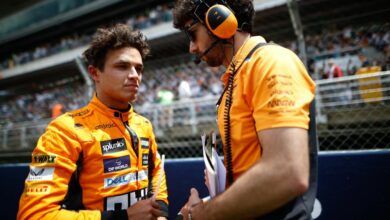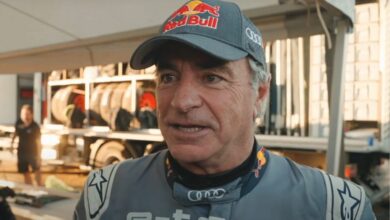McLaren’s Battle Against Low Downforce Woes: A Critical Task for 2024 F1 Season
Navigating the Challenge of Low Downforce Circuits to Secure McLaren's Dominance
The McLaren Racing team has made a pivotal revelation that it can no longer turn a blind eye to the persistent low downforce issue plaguing its MCL60 F1 car. This baffling phenomenon has been causing a disruptive disruption in the car’s aerodynamics, leading to a troublesome scenario where the aerodynamic performance essentially shuts down at low downforce levels. Addressing and rectifying this pressing concern has become a top-tier priority for the McLaren team as they gear up for the challenges of the 2024 Formula 1 season.
In the latter half of the current season, McLaren showcased significant strides in their performance, firmly establishing themselves as one of the most formidable contenders against the formidable Red Bull Racing team. However, an eyebrow-raising incident during the Las Vegas Grand Prix served as a stark reminder that rival teams seem to have a more comprehensive grasp of the intricacies involved in configuring their cars for low downforce settings.
This revelation has sent shockwaves through the McLaren pit, as they recognize the urgency of resolving the low downforce predicament that has cast a shadow over their otherwise impressive performance. The team’s commitment to delivering consistently strong results hinges on their ability to conquer this peculiar challenge.
One must acknowledge the evolving landscape of Formula 1, with an increasing number of circuits on the calendar demanding a low downforce setup. These tracks require a delicate balance of power and aerodynamics, and any compromise in the latter department can prove costly in terms of points and overall standings. With this in mind, McLaren is acutely aware that they cannot afford to concede points or positions in the upcoming season due to this peculiar low downforce quagmire.
In conclusion, the McLaren Racing team faces a significant task ahead of them as they embark on their journey into the 2024 Formula 1 season. Taming the low downforce beast that has haunted their MCL60 F1 car is not just a priority but an imperative for their continued success in the fiercely competitive world of Formula 1.
Team principal Andrea Stella disclosed that the team’s data indicated a decline in performance when operating in low downforce scenarios, in comparison to their rival teams. Speaking to the media, he conveyed:
“We seem to lose competitiveness when we need to run the car at this drag level.
“We do see, when it comes to our own observations, the fact that the aerodynamics kind of tends to switch off.
“I’m sure that’s the same for everyone, but it’s more about how large this phenomenon is – and it would look like it is slightly higher for our car than for some of our competitors.”
With the proliferation of low downforce-demanding circuits like Baku and Vegas on the Formula 1 calendar, Stella also underscored that the team could ill-afford to disregard this issue. He further emphasized:
“While we continue with the development at the medium/high downforce with what we have done this year, we have definitely added quite a lot of work at low downforce and we want to go prepared to these circuits.
“Now with Baku, with Vegas, Monza, and Spa, it starts to become a decent number of races for which you do have to have an optimised car.
“In the past, it was only Spa/Monza. So now we have added a few more races, it’s a priority.”
Emphasizing the technical aspect of the narrative, Stella further elaborated that the cars’ aerodynamics display a heightened sensitivity, leading to a non-linear loss of downforce. He clarified:
“When you go for a low rear wing, you go with a low front wing [for balance reasons], and very often this influences both ends because, when you reduce the load on the front wing, you reduce control of the front wheel wake.
“That affects then the behaviour of the car.
“So rather than simply losing [downforce] linearly, there’s a point in which you lose more than linearly. And that’s what you would like to bring back to kind of a linear loss.”
Right before the Las Vegas Grand Prix, the Woking-based team devised an ultra-low downforce configuration that incorporated a single beam wing element. However, they ultimately decided against its utilization due to the track’s low-grip characteristics. Stella reached this conclusion:
“We had a new rear wing flap.
“We had another option to run even lower drag with the beam wing, but we didn’t use it because we thought that we needed to leave some downforce on the car because of the low tarmac grip. So, we just used one of the two upgrades we had.
“But certainly, we knew that this kind of upgrade doesn’t change the personality of the car in terms of how it responds to the rear wing level, and we knew that this was going to be a bit of a struggle.”


